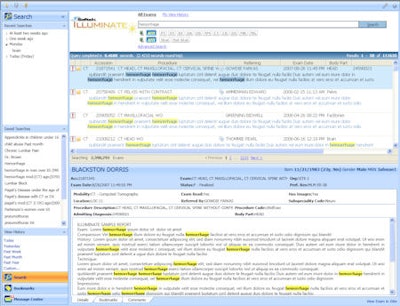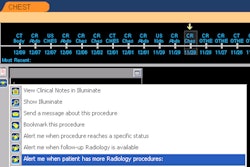
Searching for an image in a PACS can be frustrating -- if not impossible -- if you only remember details of the diagnosis. Using RIS/PACS software to keep track of whether patients recommended for follow-up exams have the procedure is a difficult task for even the most organized clinician.
A combined search engine and data mining tool designed to analyze the content of radiology reports and clinical notes could make these tasks fast and simple, as well as add a new dimension to the retrieval of clinical information contained in a PACS for both power and average PACS users alike.
Softek Solutions of Prairie Village, KS, has developed just such an application with its Illuminate software, which is designed to work with iSite PACS software from Philips Healthcare of Andover, MA.
Softek got its foothold in the healthcare IT industry by developing monitoring and management software for Millennium, Kansas City, MO-based Cerner's electronic medical record system for hospitals. CEO Matt McLenon had worked for Cerner prior to forming Softek in 1995 with current president and co-founder David Fletcher.
Softek's Panther product is a remote monitoring system designed to alert a hospital IT department whenever an anomaly occurs in any of the subsystems upon which Millennium is built. The company expects to sign its 100th customer in 2009.
Not wanting to be a single-product company, McLenon went on a national tour in 2003 to visit the chief information officers of key customers to ask what kind of healthcare IT-related problems they had in their hospitals that weren't being solved.
The discussions focused on the inability to mine free-text information contained in electronic records, McLenon said. Hospitals were making sizeable investments building data warehouses containing valuable data that couldn't be easily analyzed. But all of the hospitals had PACS, and patient records in PACS contain a large amount of clinical free text and unstructured free text that can be used in a variety of ways. This formed the genesis of the idea that became Illuminate.
"As our R&D engineers started to analyze the problem, we realized that software components we'd developed over the years could be leveraged," McLenon said. "While our vision is to develop information-gathering software that encompasses other '-ologies,' radiology seemed a great place to begin."
The Softek management team attended the RSNA annual meeting in 2007 and visited the booths of well-established PACS vendors who had the largest market share. They settled on Philips' iSite software due to its open-platform nature, which made it easier for third-party companies to develop on. Softek made its formal radiology exhibition debut at RSNA 2008.
What it does
Illuminate is a search engine and information management system that enables a clinician to instantly retrieve studies by searching for information that resides in radiology reports and clinical notes. It consists of a freestanding server that connects to the PACS network. Once installed, the software crawls through the PACS, acquiring clinical terminology and developing an index of search terms that reside on the server. This process takes several hours to several days, depending on the number of exams contained in archival storage.
After initial development of the clinical terminology index, the system automatically updates itself when new terms contained in radiology reports and clinical notes are added. The software incorporates a self-learning element to refine and expedite searches based on usage patterns, according to McLenon.
A search can be performed based on use of clinical terms alone, or search parameters can be refined by adding patient gender, age or age range, type of procedure, body part, and/or range of dates in which the procedure was performed. The size of the PACS database does not affect search time. Because the search is conducted from the Illuminate server, it also does not impact PACS workflow.
 |
| Softek's Illuminate allows various search options. Image courtesy of Softek Solutions. |
Studies that meet the search parameters are displayed in a list on the PACS workstation, with pointers to the actual studies. Mouseclicking these bookmarks will open either the radiology report or the PACS.
The management capabilities of the software include the ability to create folders of any image retrieved, and files can include comments. Users can request that future similar studies automatically be added to a file. Updates relating to individual patients, such as notification that a recommended follow-up exam was performed, linkage, and instant access to the images and report of the follow-up are key features.
How it's used
Current uses by customers include the following:
- Developing teaching files
- Developing disease-specific reference and classic case files
- Patient exam follow-up
- Analyzing changes in reported diagnoses
- Radiology peer review
- Quality assurance checks to verify that protocols for specific procedures are being followed
Dr. John Gaspar, a staff radiologist at Kettering Radiologists in Dayton, OH, works with radiology residents. He told AuntMinnie.com that the tool is an incredible boon for resident training.
"If a resident wants to see what appendicitis looks like in our practice, he can perform a search in a matter of seconds to see what mild, moderate, and acute appendicitis looks like, and view 100 cases of images acquired from x-ray, CT, and ultrasound," Gaspar said.
"Our residents can create personal electronic reference files, which take up no storage because the file listings are simply bookmarks," he continued. "In my opinion, this is a hugely important learning tool, because standard teaching files do not exactly match our geographic patient population or the scanning protocols we use."
Customers include Henry Ford Health System in Detroit and the University of Chicago Medical Center, where Dr. Paul Chang, co-founder of iSite's developer Stentor, is director of enterprise imaging.
Softek sells Illuminate to iSite customers directly. Sales can be made either under a customer's capital or operational budget, or on a subscription or fee-per-study basis.
"Our customers tell us that using Illuminate becomes addictive and spreads throughout an organization as clinicians find new ways to use it," McLenon said.
By Cynthia E. Keen
AuntMinnie.com staff writer
May 1, 2009
Related Reading
E-learning tool may offer value in radiology education, March 10, 2009
PACS software tool boosts clinical follow-up, December 15, 2008
Using PACS to meet communications challenges, February 7, 2008
Copyright © 2009 AuntMinnie.com



















